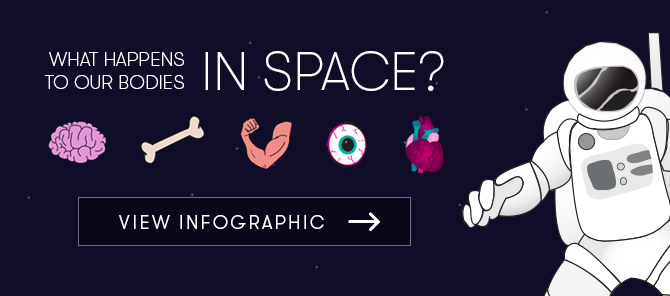Humans in space
Expert reviewers
Essentials
- Being in space affects the human body both physically and psychologically.
- Tasks that are simple on Earth, such as going to the toilet, become much more difficult in space.
- Extremely complex and costly equipment is used to help humans eat, sleep and go to the toilet.
- The effects of being in space can last even after an astronaut has returned to Earth.
- Astronauts need to exercise for two hours a day to maintain their strength and fitness in the microgravity environment of space.
Humans have gazed at the stars, marvelled at the universe and dreamed of what lay beyond for millennia. Our heads were in the sky, but our feet were firmly planted on the ground. This all changed on 12 April 1961, when Russian cosmonaut Yuri Gagarin became the first human being to make it into space—and back again.
Since then, more than 500 people have ventured into space. In the decades to come, even more will undertake this adventure.
We have created some of the most technically advanced equipment and machinery to blast us into space, allow us to reside there for a while, and get us home again. But, at the end of the day, astronauts are still human. They still need to eat, sleep, move, breathe, have a wash, be entertained and go to the toilet. So how do they do it?
Breathing
Of all the things humans need to do to survive, breathing is number one. The atmosphere on Earth makes this easy; we’re perfectly adapted to live on our planet. But space is a whole new ball game.
Incredibly complex technology is needed to not only provide astronauts with reliable, continuous fresh air, but also to remove the carbon dioxide they breathe out, as well as the other gases which people emit in small quantities (such as methane from farts and ammonia from sweat).
On the International Space Station (ISS), there are two systems that generate oxygen. In the Russian segment the system is called ‘Elektron’ and in the US segment there is the imaginatively named ‘Oxygen Generation System’, or OGS. The Elektron system is situated in the service module (Zvezda), while the OGS (also known as the Environmental Control and Life Support System, or ECLSS) is located in the Destiny laboratory module.
Both systems produce oxygen using a process called electrolysis GLOSSARY electrolysischemical decomposition produced by passing an electric current through a liquid or solution containing ions which uses electricity generated from the station’s solar panels to split water molecules (H2O) into molecules of hydrogen gas and oxygen gas. As NASA explains, each molecule of water contains two hydrogen atoms and one oxygen atom. Running a current through water causes these atoms to separate and recombine as gaseous hydrogen (H2) and oxygen (O2).
The oxygen produced through this process is recycled into the cabin of the ISS, allowing astronauts to breathe easy. But what about the hydrogen produced in the process? It used to be thrown overboard, but is now put to good use. In a closed unit, it is combined with carbon dioxide (which is breathed out by the crew and captured by CO2 scrubbers GLOSSARY scrubbersCO2 scrubbing involves the use of heterogeneous granules of a synthetic rock called zeolite (also known as a molecular sieve). When the cabin fans blow air through the bed of rocks, CO2 and water stick to the zeolite, while everything else passes through ) to produce water and methane. The water is then recycled into hydrogen and oxygen. Methane is vented overboard into space.
This electrolysis of water provides around 5.4 kilograms of oxygen per day for four inhabitants. This can be increased to 9 kilograms a day for a crew of six.
If these systems break down, there are two back-up options. Oxygen can be made chemically using the Vika oxygen generator. A chemical reaction using solid fuel (lithium perchlorate) can be initiated to create oxygen. This system can provide oxygen for one person for one day. If this also fails, there are emergency cylinders of bottled compressed oxygen.
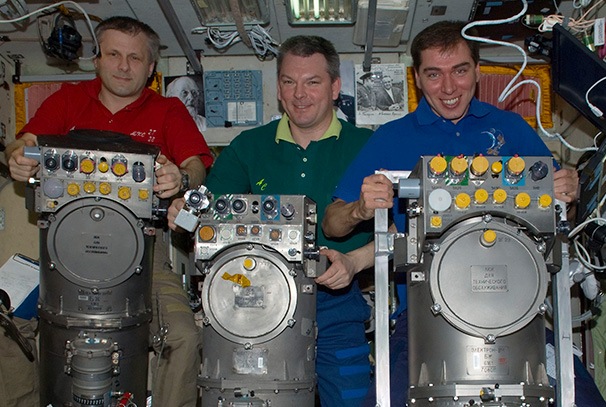
Hygiene
The scoop on poop
When you gotta go, you gotta go. On Earth it’s easy—you walk to a toilet, sit down and do your business. There are a few things you take for granted: that gravity will keep you seated, and that your waste will drop away from you. In the low-gravity environment of space, going to the toilet becomes a bit more complicated. So complicated, in fact, that astronauts undergo toilet training prior to any mission. This is done to ensure they know how to use the space toilets—which, incidentally, can cost up to US$19 million each.
On the ISS, toilets are equipped with footholds to keep you in place, and both men and women can urinate standing up (or, at least, floating in a vertical position). Astronauts use a funnel attached to a hose adapter, where fans and air suck the liquid away and into a storage container. Men and women use different-shaped funnels—the female version is oval and 5 centimetres by 10 centimetres at the rim, while the male version is 10 centimetres deep and 7.5 centimetres wide. Interestingly, it’s actually easier for women to urinate in space, as the top of the funnel is placed directly against their bodies and adheres to them prior to the suction being turned on. Men have to ensure that their funnel is placed close enough to catch the liquid, but not so close as to be caught in the vacuum itself—a delicate balancing act!
Water is a precious commodity on the space station. Since 2008, astronauts’ urine has been chemically treated and processed, which turns it back into potable water that is re-consumed. Astronaut Don Pettit summed it up well when he said, ‘Yesterday’s coffee becomes today’s coffee’.
Originally, NASA scientists hoped to recover around 85 per cent of the water in the collected urine. However, living in microgravity GLOSSARY microgravityvery weak gravity, as in an orbiting spacecraft can cause loss of bone density in astronauts, resulting in very high levels of calcium in their urine. This reduces the water recovery to only 70 per cent.
If that sounds a bit disgusting, consider this: the treatment process is so sophisticated that the water is cleaner and more pure than much of that drunk on Earth. The US$250 million filtration system supplies an additional 6,000L of drinking water to the ISS each year.
But urine could have another use in space. Scientists at NASA are currently working on a system that may be able to use urine to generate electricity. Using what’s called ‘forward osmosis’, the system pulls water out of urine using a concentrated mixture of sugar and salt. The leftover waste from the urine is rich in nitrogen, which can then be converted into ammonia. This could be used as fuel for generators that make … yep, electricity!
If it’s time for a number two, then astronauts sit down and secure themselves to the toilet using the footholds, or by holding onto handles on either side of the ‘bowl’. The opening on a space toilet is only around 10 centimetres wide; this is to ensure your waste stays where you put it. Flowing air in the toilet pulls waste away from the body—a bit like a vacuum cleaner—to stop any of it escaping and floating around the cabin. The waste is held in a storage tank, which is then exposed to the vacuum of space. This freeze-dries the contents and kills any bacteria, resulting in odour-free, non-toxic poop. The waste is then stored for the remainder of the mission. The stored waste is placed into an unmanned supply ship, where it burns up on re-entry to Earth. So the next time you gaze in wonder at a shooting star, take a moment to consider that it might, in fact, be astronaut poo blazing in the night. The air used in the toilets is also filtered to remove bacteria and odours, and is then returned to the cabin.
If these very complex systems break down, it’s back to basics—a bag that’s taped to the buttocks and can be sealed once it’s filled.

Shooting star, or the last dash of astronaut poo? Image source: Sergiu Bacioiu / Flickr.
Menstruation
Female astronauts have to contend with one more challenge than their male counterparts: menstruation.
There was some concern in the 1970s that the low-gravity environment of space could produce ‘retrograde menstruation’, where menstrual blood flows back up into the fallopian tubes rather than out of the body, causing pain, discomfort and possibly leading to endometriosis. This theory was found to be false, and women who have been to space report that everything works the way it normally does. They still got their period, and dealt with it in much the same way as they would on Earth, using a variety of products such as tampons and pads.
Some female astronauts choose to use hormone drugs that stop menstruation, others do not.
Freshening up
If you’ve worked up a bit of a sweat during your space shift, how do you freshen up? Living in such confined conditions with other astronauts means good hygiene is essential.
The lack of gravity in space means astronauts have to get creative in the ways they clean themselves.
On Earth you’d stand under a hot shower or lie back in a warm bath. But in space, all that water would simply float away. So most astronauts have sponge baths, where they moisten a cloth with pre-mixed soapy water, wipe themselves down, and then dry off.
For washing their hair, astronauts use a no-rinse shampoo, which is applied, rubbed in and then wiped off. Shaving in space is possible, with most astronauts using an electric razor that collects the hair as it goes. It’s important that no loose hairs or whiskers fall off the towel, as these can create a safety hazard within the cabin, particularly if they are inhaled or clog filters and other on-board equipment.
Brushing teeth is not so different in space, because toothpaste stays on the brush (astronauts just need to squeeze the tube upright and catch the paste on the brush). Even water stays—it forms a bubble over the head of the brush due to surface tension. After brushing, astronauts either swallow the paste or spit it into a paper towel. Edible toothpaste is also available, and reduces water use.
With no washers or dryers in space, clothes are disposable. Inside the space station, astronauts wear normal everyday clothes—spacesuits are only needed for work outside the station. Socks and underwear are changed daily or every second day, t-shirts are changed weekly, and pants or shorts are worn for a month then thrown out.
Sleeping
After a hard day’s work orbiting Earth, there’s nothing an astronaut wants more than to lie down and have a good sleep. But sleeping in space is difficult for a number of reasons.
Firstly, it’s noisy. You’d think all that space would be nice and quiet, but astronauts are constantly surrounded by noise. Generators, fans, condensers, air filters and other equipment are constantly humming, whirring and beeping.
Secondly, it’s light. If you think it would be pleasant to fall asleep surrounded by a million stars, remember that, for astronauts on the ISS, the sun rises every 90 minutes—roughly the amount of time it takes the space station to circumnavigate Earth. Experiencing 16 sunrises in 24 hours can completely throw out the circadian rhythms GLOSSARY circadian rhythmsare physical, mental and behavioural changes that follow a roughly 24-hour cycle, responding primarily to light and darkness in an organism's environment. They are found in most living things, including animals, plants and many tiny microbes. of the body. The lights on board the space station itself can also be difficult to block out.
Microgravity poses its own problems too—there’s no up or down, so you don’t get a sensation of lying flat. Astronauts have to tether their sleeping bags to the floor or the wall so that they don’t float around and bump into things while they sleep, and most use restraints to stop their arms floating above their heads. While floating arms aren’t painful, they can be a bit unsettling. Individual sleeping quarters can also be used. These small spaces contain a pillow, a sleeping-bag, a light, a place for a few personal belongings and an air vent—essential to ensure that the carbon dioxide produced from breathing isn’t re-inhaled.
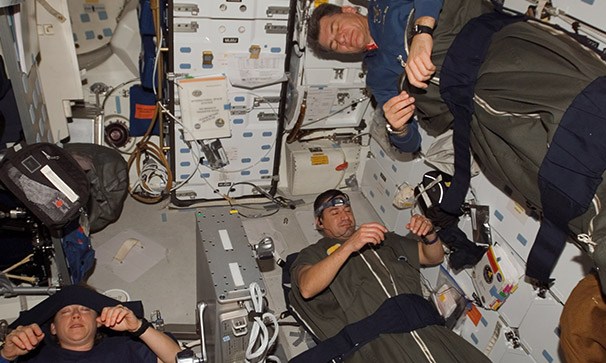
Astronauts can use earplugs to block sound, eye masks to block light and, as a last resort, sleeping tablets to help them drift off. Even with these methods, insomnia and sleep deprivation are serious and relatively frequent problems for people living in space. In fact, sleeping pills are the second most common medication taken by astronauts (painkillers are number one), and most astronauts only average around 6 hours sleep in a 24-hour cycle.
The length and quality of sleep affects the body’s ability to concentrate, its energy levels and its long-term physical health. In recognising the importance of sleep, NASA schedules eight-and-a-half hours of sleep for astronauts every day, encourages sleep relaxation techniques and provides pre-mission sleep training. NASA is also continually experimenting with the lighting used on the ISS, such as moving from fluorescent lights to colour-changing LEDs (light emitting diodes), to find better systems which may help, rather than hinder, an astronaut’s ability to sleep.
Eating
It’s quite possible astronauts floating 370,000 metres above Earth enjoyed a similar meal last night to the one you ate at home. Early space food was basic and unappetising, often consisting of bite-sized cubes, freeze-dried powders and semi-liquids sucked out of aluminium tubes. Today, the range of options is impressive. Some space meals are even designed and cooked by celebrity chefs.
Each astronaut is allocated three meals a day, plus snacks. Menus are diverse and cater to all tastes and dietary requirements. Food choices might include beef stroganoff, chicken curry, brownies, scrambled eggs, muesli bars, even mac and cheese! Most menus are chosen by NASA and operate on a 10-day cycle, but astronauts can also select the food they want to eat prior to the mission taking off. The Canadian Space Agency has released Chris Hadfield's menu from Mission Expedition 34/35.
Diets are closely monitored to ensure that astronauts receive the recommended daily intake (RDI) of vitamins, minerals, calories and nutrients to perform the required duties in space.
The main difference between food eaten on Earth and that consumed in space is its packaging and design. In space, it not only has to last a long time, but must be carefully contained so that it doesn’t float around and potentially damage equipment.
On the ISS, for example, food comes prepared in four different ways— rehydratable GLOSSARY rehydratableable to be rehydrated by adding liquid , thermostabilised GLOSSARY thermostabilisedpreserved by heat, usually under pressure , irradiated GLOSSARY irradiateda form of food processing that extends shelf life and reduces spoilage. Foods such as fruits, vegetables, spices and meats can be exposed to radiation to kill insects, moulds and microorganisms. , and natural. Each meal comes in its own special, colour-coded packaging—even condiments such as salt and pepper are stored in liquid to stop the small particles from escaping and floating away.
It takes around 20 to 30 minutes to rehydrate or heat a meal, which is generally faster than preparing one on Earth!
Astronauts can’t put their food on a plate—it would float around and cause havoc. On the Space Shuttle, a meal tray can be strapped to the astronaut’s lap or attached to the wall, and holds all the various containers and packages, allowing the eater to choose from several foods at once. On the ISS, most astronauts use a round ‘coin’ of Velcro on each package to secure it to the wall or to one’s own clothing. It’s relatively easy to eat from several packages of food at once because, due to surface tension, the food will generally stay put when unattended. Cutlery consists of knife, fork, spoon … and scissors (for cutting open the packages). Packages are discarded in the trash compartment, and utensils are cleaned with moistened wipes.
Entertainment
An astronaut’s day is highly organised. Meals, sleep, chores, exercise and rest time are all carefully planned and scheduled. So—when astronauts do have some downtime, what do they do?
While gazing out the windows of the International Space Station and seeing our planet is named by astronauts as one of the most relaxing things to do, they also have other ways of passing the time.
Connecting with family and friends back on Earth or catching up on the latest news are the most popular pastimes. Email, internet phone and private video conferences make communicating relatively easy. Contact with ‘home’ is important, particularly for maintaining good emotional and mental wellbeing.
Care packages—both electronic and physical—are put together by family and friends prior to a mission for astronauts to open when they’re in space. Electronic care packages can contain family photos, messages, reading material and video clips, while the physical packages contain a range of items including CDs, magazines, books and letters. The ISS also has its own library with books, CDs and music. The internet has also been available on the ISS since 2010, so astronauts can even watch funny cat videos if they’re really bored!
The realities of being in space—microgravity for instance—can also be a source of amusement. Floating around between modules or watching how everyday substances (like water) react to the different conditions can be entertaining. Science experiments can also be conducted, with results both interesting and unexpected.
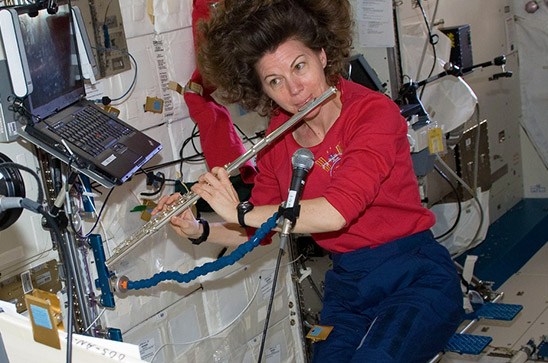
The human body in space
Floating around all day might seem like fun, but it can be damaging to your health. The microgravity experienced in space can affect the human body—its muscles, bones, cardiovascular system, fluids in the arteries, and balance—in various ways.
Muscles
With no weight or load being placed on the body, the muscles—particularly the leg and back muscles which on Earth are used daily for posture—can begin to weaken and atrophy.
Bones
Without any load being placed on them, bones (primarily in the legs, back and spine), like muscles, begin to break down, releasing calcium which is reabsorbed into the body, leaving bones brittle and weak. Astronauts can lose between 1 and 3 per cent of their bone density each month (compared to 1 per cent per year on Earth). The calcium released by the bones can also increase the risk of kidney stones. Astronauts need to stay strong so they can manoeuvre heavy spacesuits and complete rigorous spacewalks. They also need to maintain their strength so that when they return to Earth, their bodies will be able to walk and function normally. Current countermeasures (such as regular, scheduled exercise) have seen astronauts return to Earth with almost no bone-density loss.
Interestingly, the human spine lengthens when in space. On Earth, gravity slightly compresses the discs between the vertebrae of the spinal column. In microgravity, compression is removed, resulting in a slight lengthening of the spine and a taller astronaut. But this sudden growth spurt can cause back pain and, when astronauts return to Earth, they shrink back to their normal height.
Fluid shift
On Earth, gravity works to distribute blood and other fluids around your body, particularly to the legs. In space, these fluids are redistributed towards the upper part of the body and away from the limbs and extremities. This fluid shift can cause puffiness of the face, and limbs that are smaller in circumference. If you look at photos of astronauts in space, you’ll see that their legs often look skinny. Microgravity can also result in the loss of plasma.
Cardiovascular system
It’s not only the muscles and bones that slack off in space. The heart, too, doesn’t have to work as hard in a microgravity environment as it does on Earth. This can potentially lead to a deconditioning of the heart muscle, making it weaker and smaller. Space radiation may also affect the endothelial cells (the lining of blood vessels), which could initiate or accelerate coronary heart disease.
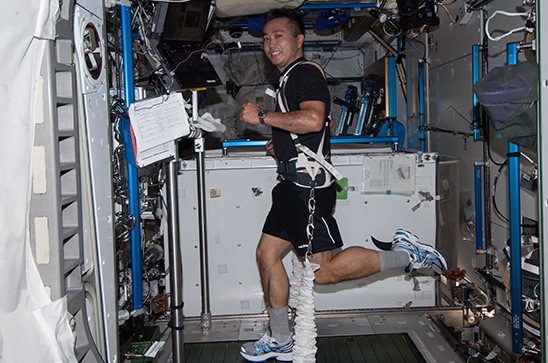
Balance systems and inner ear
On Earth, our balance, vision and orientation within a space are all controlled and regulated through a complex series of integrated neural pathways. The brain receives signals and interprets information from the various sense organs, particularly the inner ear, the eyes and the deep senses from joints and muscles. But in space, these signals are confused, mixed up and changed. This can result in astronauts experiencing space motion sickness, disorientation and a loss of sense of direction. These effects can have an impact on a range of operational activities, such as remote manipulation GLOSSARY remote manipulationfor example, a human controlling a robotic arm to perform a task. , approaching, landing or docking. When astronauts return to Earth, the reintroduction of gravity requires a major readjustment, and can result in problems standing, walking, turning and focusing their gaze.
Mental health
‘Beyond imagination’. That’s how astronaut William McCool described seeing Earth from above. Other astronauts have agreed, describing how space flight changed in a profound way how they saw their place in the universe. Being in space—above the planet; away from friends, family and all that’s familiar; isolated and confined in an often stressful, challenging and reduced sensory environment; can impact an astronaut’s psychological health in various ways. In fact, NASA considers behavioural and psychiatric conditions to be one of the most significant risks to the success of any space mission.
Astronauts can experience frequent hallucinations, described by Don Pettit as ‘flashes in my eyes, like luminous dancing fairies.’ They are caused by cosmic rays which cause the nerve cells in the eye to produce the effect. Although disconcerting, these hallucinations can be the least of an astronaut’s worries.
Stress, isolation, confinement in a limited space and tension with crew members can all contribute to reduced mental health and wellbeing. A common problem could be claustrophobia (a reaction to being in a confined space). Astronauts receive special training (and if necessary, exclusion) if they show susceptibility to it.
Research has also suggested that the human brain may function differently in space. Many basic abilities like coordination, attention span, task-switching and problem solving appear to work less well in space. This could be due to a number of factors, including how the brain receives oxygen in a microgravity environment.
Spacesuits
Spacesuits are worn outside the space station and are extremely complex pieces of technology.
In fact, the name does them an injustice—much more than just a suit, they’re actually like a small version of a spacecraft. Formally known as an Extravehicular Mobility Unit (EMU), they have multiple roles to fulfil to keep their occupants safe. They must provide oxygen, allow sight and movement, and protect the wearer from the hazards of space such as radiation, a pressurised atmosphere, space dust and micrometeoroids, while also keeping the body at a comfortable and regulated temperature.
Each suit has 13 layers, weighs 127 kilograms, takes 25 steps to get in and out of, and costs around US$12 million dollars.
Before getting into the suit, astronauts first put on a Maximum Absorbency Garment—a technical name for an adult nappy. Because spacewalks can last upwards of six hours without a break, these are needed to absorb any waste the astronaut might produce during that time.
Over the nappy, astronauts dress in an undergarment that covers their entire body, leaving only the hands, feet and head uncovered. This special outfit, known as a Liquid Cooling and Ventilation Garment, has tubes woven through it, through which water flows to keep the astronaut cool.
Sections of the spacesuit include a hard upper torso; arms and gloves; a displays and control module; an in-suit drink bag; a lower-torso assembly (including pants, boots and the lower half of the waist enclosure); a helmet; and a communications carrier assembly (also known as the Snoopy Cap). All pieces of the suit interlock so that no part of the astronaut’s body is exposed to space.
One of the most recognisable aspects of a spacesuit is the backpack, but it doesn’t hold the astronaut’s lunch. Known as the Primary Life Support Subsystem, it contains essential oxygen so the wearer can breathe, and also removes the carbon dioxide which has been breathed out. The backpack also supplies electricity to keep the suit functioning. It powers a fan that moves oxygen through the suit and a water tank that holds cooling water which flows through the undergarment tubes. But the most exciting part of the backpack is the thruster jets, which astronauts can use to fly back to the space station if they have floated away. These jets are part of device called the Simplified Aid for Extravehicular Activity Rescue, or SAFER. A very apt name for such a useful piece of equipment.
When astronauts return to the shuttle after a spacewalk, there is a lingering smell on their suits, said to resemble burnt metal. This is what space smells like.
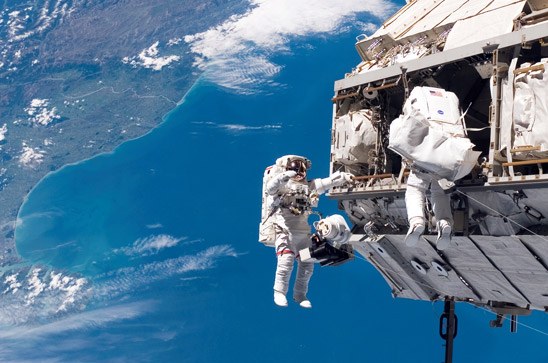
Conclusion
Space might be the final frontier, but those who go there still need to do all the things that humans on Earth do. Decades of research, planning, testing and evaluation have allowed scientists to work out how to manage the intricacies of the human body and its various functions while in space, and ways of surviving and thriving there are continuously being refined and improved upon. It seems that the challenges of living in space are no match for the ingenuity, determination and creativity of the human spirit.






